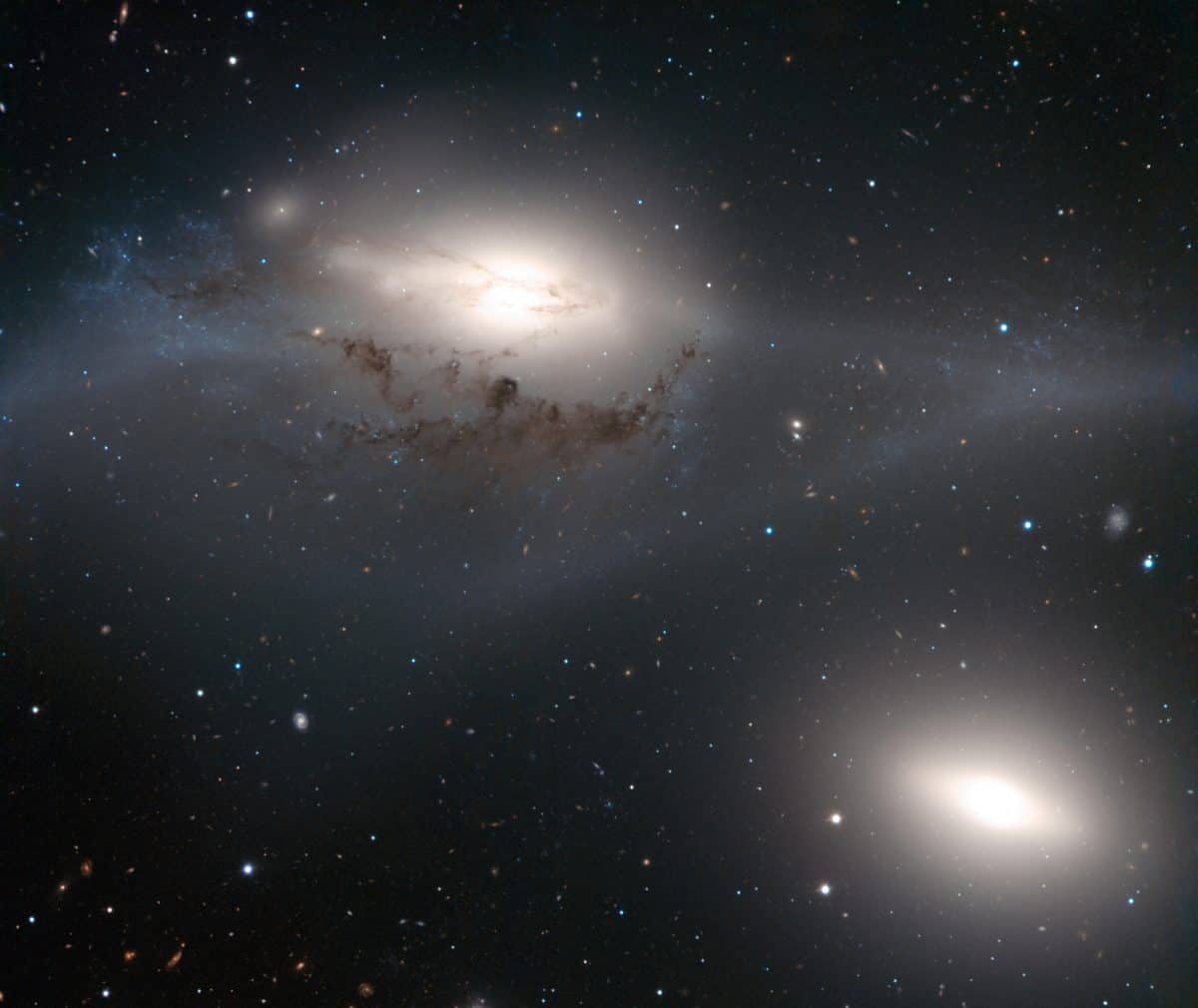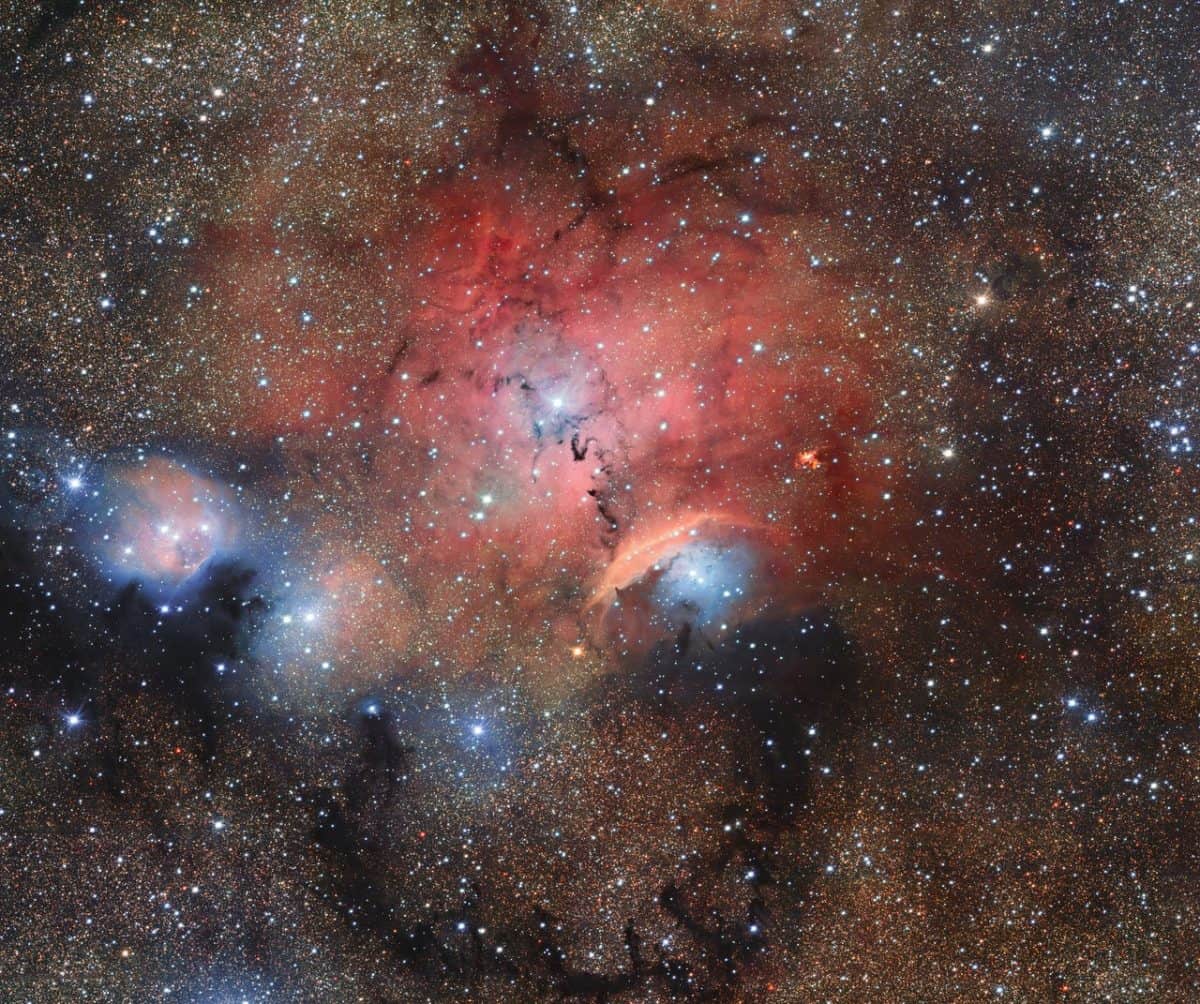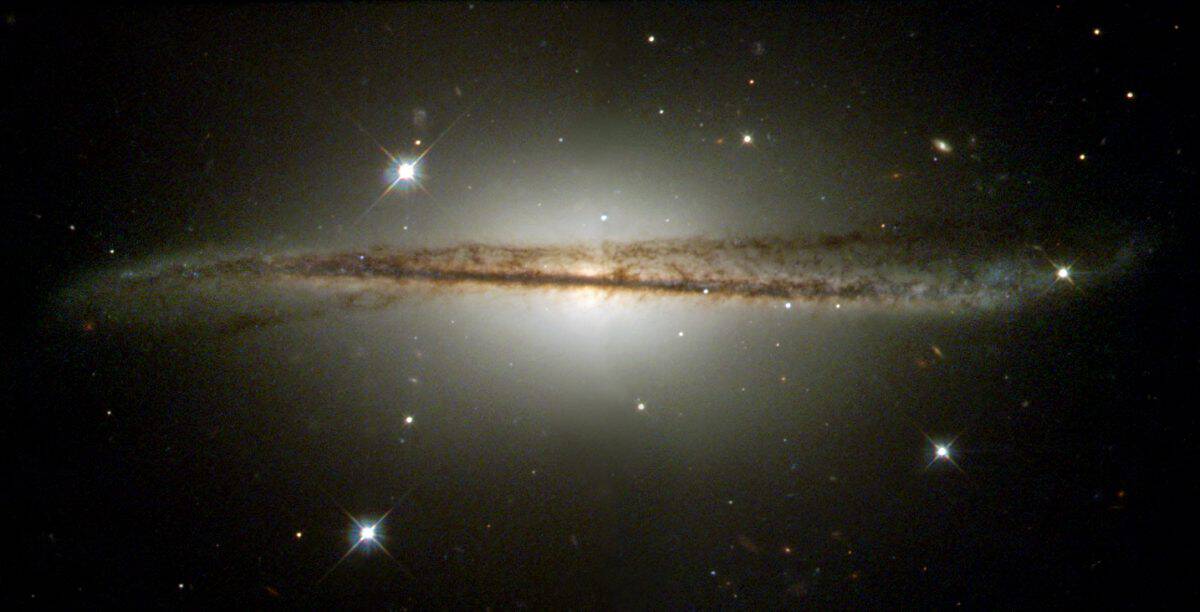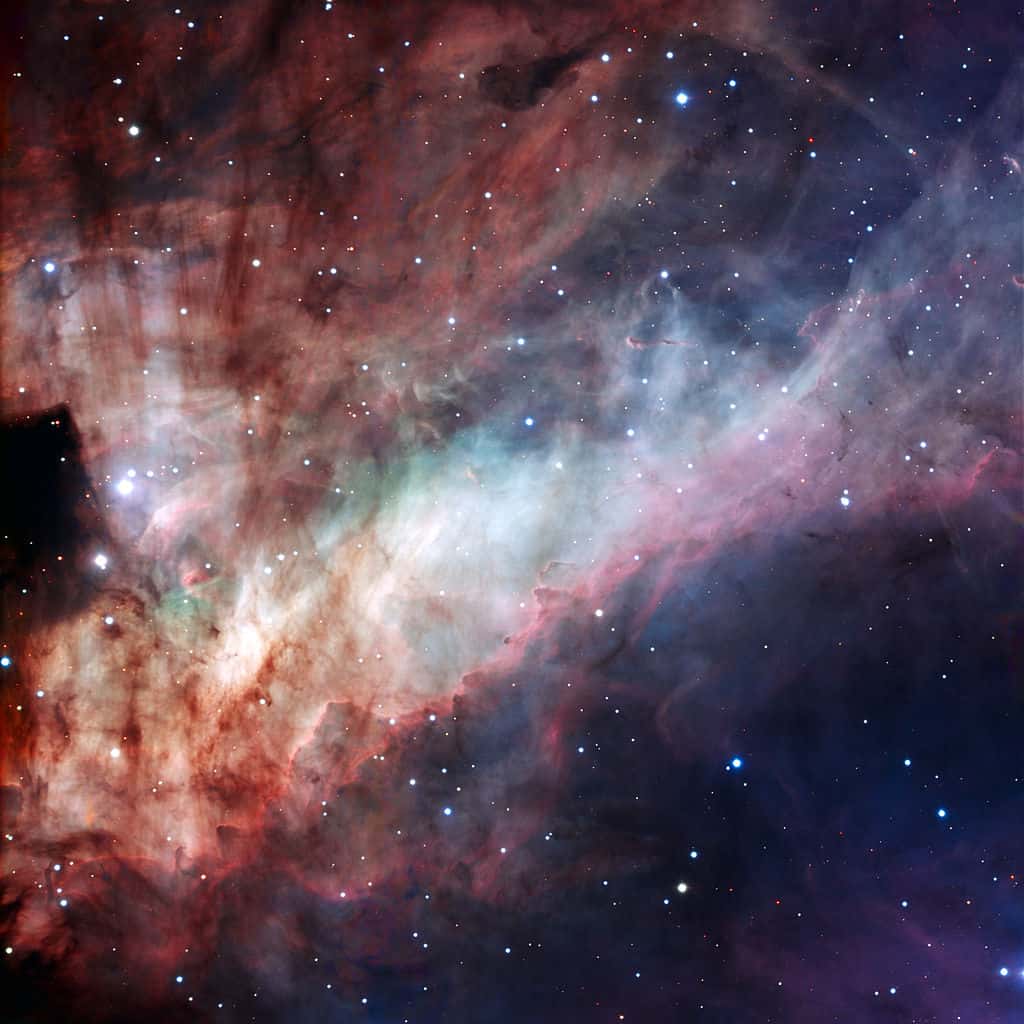Blog
Two exceptional musician representing distinct traditions and harps celebrate the magnificent osprey bird on their album titled Soar.Welsh musician Catrin Finch plays the Welsh harp and contributes the Celtic and western classical traditions. Senegalese kora player contributes the musical influences of West Africa and his world music collaborations. The result is a superb set of musical pieces where the two forms of harps engage in a beautiful genre-defying dialog.
more...Sounds of Thunder
more...This striking image, taken with the FORS2 instrument on the Very Large Telescope, shows a beautiful yet peculiar pair of galaxies, NGC 4438 and NGC 4435, nicknamed The Eyes. The larger of these, at the top of the picture, NGC 4438, is thought to have once been a spiral galaxy that was strongly deformed by collisions in the relatively recent past. The two galaxies belong to the Virgo Cluster and are about 50 million light-years away.
The Eyes Galaxies (NGC 4435-NGC 4438, also known as Arp 120) are a pair of galaxies about 52 million light-years away in the constellationVirgo. The pair are members of the string of galaxies known as Markarian’s Chain.
NGC 4435 is a barred lenticular galaxy currently interacting with NGC 4438. Studies of the galaxy by the Spitzer Space Telescope revealed a relatively young (190 million years) stellar population within the galaxy’s nucleus, which may have originated through the interaction with NGC 4438 compressing gas and dust in that region, triggering a starburst. It also has a long tidal tail possibly caused by the interaction with the mentioned galaxy; however, other studies suggest that tail is actually a galactic cirrus in the Milky Way totally unrelated to NGC 4435.
NGC 4438 is the most curious interacting galaxy in the Virgo Cluster, due to the uncertainty surrounding the energy mechanism that heats the nuclear source; this energy mechanism may be a starburst region, or a black hole-powered active galactic nucleus (AGN). Both hypotheses are currently under investigation by astronomers.
This galaxy shows a highly distorted disk, including long tidal tails due to the gravitational interactions with other galaxies in the cluster and its companion. The aforementioned features explain why sources differ to classify it as a lenticular or spiral galaxy. NGC 4438 also shows signs of a past, extended, – but modest – starburst, a considerable deficience of neutral hydrogen, as well as a displacement of the components of its interstellar medium – atomic hydrogen, molecular hydrogen, interstellar dust, and hot gas – in the direction of NGC 4435. This observation suggests both a tidal interaction with NGC 4435 and the effects of ram-pressure stripping as NGC 4438 moves at high speed through Virgo’s intracluster medium, increased by the encounter between both galaxies.
more...The keyboardist Eddie Green established a permanent connection with several aspects of the Philadelphia music scene, including both Philly soul and Philly jazz. Green had come up in the ’50s studying with Richie Powell, brother of famed pianist Bud Powell (no slouch himself). He became a member of a widely admired, cutting-edge jazz fusion outfit and fit comfortably into the sophisticated soul happening between steak and cheese sandwiches at recording studios. Despite his talent and potential, it became something of a cliché that nobody would have heard or seen this shade of Green or anything he was involved in unless they resided in Philadelphia or someplace nearby.
While he played on some R&B sessions in the years prior, Green doesn’t start showing up in jazz discographies until the late ’60s. At that point, he’s in hot and heavy company including the fine guitarist Pat Martino, with whom Green kept up a regular collaboration, as well as alto saxophone master Sonny Criss. The ensemble Catalyst became an important part of Green‘s résumé, an intense grouping that also included saxophonist and bandleader Odean Pope. The group made a series of albums on the Muse label in the first half of the ’70s that wisely blended avant-garde, hard bop, Philly soul and even touches of classical. There was a buzz about this band with hipsters, and the group’s reputation has only been strengthened by historic appraisal. Nonetheless nobody involved with the group gained much in terms of immediate fame and fortune. Green also performed and recorded much less diverse music with the Three Degrees. His activities in Philadelphia included teaching music. Green put out an album under his own name, This One’s for You after about a half a century in the music business.
more...Richard Arnold “Groove” Holmes real name: Richard Arnold Jackson (May 2, 1931 in Camden, New Jersey – June 29, 1991 in St. Louis, Missouri) was an American jazz organist who performed in the hard bop and soul jazz genre. He is best known for his 1965 recording of “Misty“, and is considered a precursor of acid jazz.
Holmes’ first album, on Pacific Jazz with guest Ben Webster, was recorded in March 1961.
He recorded many albums for Pacific Jazz, Prestige Records, Groove Merchant and Muse Records, many of which featured Houston Person.
Holmes died after a long struggle with prostate cancer, having performed his last concerts in a wheelchair. One of his last gigs was at the 1991 Chicago Blues Festival with his longtime friend, singer Jimmy Witherspoon. A year after his death, the Beastie Boys honoured Holmes by adding an organ-based instrumental track, “Groove Holmes”, to their album Check Your Head.
https://www.youtube.com/watch?v=Ihr49x0FIj4
more...Shto Mi E Milo (Macedonia)
more...Conquer Me Dub
more...The OmegaCAM imager on ESO’s VLT Survey Telescope has captured this glittering view of the stellar nursery called Sharpless 29. Many astronomical phenomena can be seen in this giant image, including cosmic dust and gas clouds that reflect, absorb, and re-emit the light of hot young stars within the nebula.
Sharpless 29 is located 5,500 light years away from us in the constellation of Sagittarius (the Archer), and sits right next to the famous Lagoon Nebula.
more...Judith Marjorie Collins (born May 1, 1939) is an American singer and songwriter known for her eclectic tastes in the material she records (which has included folk music, show tunes, pop music, rock and roll and standards) and for her social activism.
Collins’ debut album A Maid of Constant Sorrow was released in 1961, but it was the lead single from her 1967 album Wildflowers, “Both Sides, Now” — written by Joni Mitchell — that gave Collins international prominence. The single hit the Top 10 on the Billboard Pop Singles chart and won Collins her first Grammy Award for Best Folk Performance. She enjoyed further success with her recordings of “Someday Soon“, “Chelsea Morning“, “Amazing Grace“, and “Cook with Honey”.
Collins experienced the biggest success of her career with her recording of Stephen Sondheim‘s “Send in the Clowns” from her best-selling 1975 album Judith. The single charted on the Billboard Pop Singles chart in 1975 and then again in 1977, spending 27 non-consecutive weeks on the chart and earning Collins a Grammy Award nomination for Best Pop Vocal Performance, Female, as well as a Grammy Award for Sondheim for Song of the Year.
Shirley Valerie Horn (May 1, 1934 – October 20, 2005) was an American jazz singer and pianist. She collaborated with many jazz greats including Miles Davis, Dizzy Gillespie, Toots Thielemans, Ron Carter, Carmen McRae, Wynton Marsalis and others. She was most noted for her ability to accompany herself with nearly incomparable independence and ability on the piano while singing, something described by arranger Johnny Mandel as “like having two heads”, and for her rich, lush voice, a smoky contralto, which was described by noted producer and arranger Quincy Jones as “like clothing, as she seduces you with her voice”.
Shirley Horn was born and raised in Washington, D.C.. Encouraged by her grandmother, an amateur organist, Horn began piano lessons at the age of four. Aged 12, she studied piano and composition at Howard University, later graduating from there in classical music. Horn was offered a place at the Juilliard School, but her family could not afford to send her there. Horn formed her first jazz piano trio when she was 20. Horn’s early piano influences were Erroll Garner, Oscar Peterson and Ahmad Jamal, and moving away from her classical background, Horn later said that “Oscar Peterson became my Rachmaninov, and Ahmad Jamal became my Debussy.
more...Marion Walter Jacobs (May 1, 1930 – February 15, 1968), known as Little Walter, was an American blues musician, singer, and songwriter, whose revolutionary approach to the harmonica and impact on succeeding generations earned comparisons for him to such seminal artists as Django Reinhardt, Charlie Parker and Jimi Hendrix. His virtuosity and musical innovations fundamentally altered many listeners’ expectations of what was possible on blues harmonica. He was inducted into The Rock and Roll Hall of Fame in 2008 in the category Sideman, the only artist to be inducted specifically as a harmonica player.
Jacobs was born in 1930 (recently uncovered census data suggests he may have been born earlier, possibly as early as 1925)[citation needed] in Marksville, Louisiana, and raised in Rapides Parish, Louisiana, where he learned to play the harmonica. He quit school and by the age of 12 had left rural Louisiana and travelled, working odd jobs and busking on the streets of New Orleans; Memphis; Helena and West Helena, Arkansas; and St. Louis. He honed his musical skills on harmonica and guitar performing with older bluesmen, including Sonny Boy Williamson II, Sunnyland Slim, Honeyboy Edwards and others.
Arriving in Chicago in 1945, he occasionally found work as a guitarist but garnered more attention for his already highly developed harmonica playing. According to Chicago bluesman Floyd Jones, Little Walter’s first recording was an unreleased demo recorded soon after he arrived in Chicago, on which Walter played guitar backing Jones.
more...Vocalist and percussionist Xavier Diaz revisits and transforms the traditional folk songs and dances of Galicia (northwestern Spain).
more...Repatriation
more...NASA’s Hubble Space Telescope has captured an image of an unusual edge-on galaxy, ESO 510-G13, revealing remarkable details of its warped dusty disk and showing how colliding galaxies spawn the formation of new generations of stars. The dust and spiral arms of normal spiral galaxies, like our own Milky Way, appear flat when viewed edge-on. This image shows a galaxy that, by contrast, has an unusual twisted disk structure, first seen in ground-based photographs obtained at the European Southern Observatory (ESO) in Chile. ESO 510-G13 lies in the southern constellation Hydra, roughly 150 million light-years from Earth. Details of the structure of ESO 510-G13 are visible because the interstellar dust clouds that trace its disk are silhouetted from behind by light from the galaxy’s bright, smooth central bulge. The strong warping of the disk indicates that ESO 510-G13 has recently undergone a collision with a nearby galaxy and is in the process of swallowing it. Gravitational forces distort the structures of the galaxies as their stars, gas, and dust merge together in a process that takes millions of years. Eventually the disturbances will die out, and ESO 510-G13 will become a normal-appearing single galaxy. In the outer regions of ESO 510-G13, especially on the right-hand side of the image, we see that the twisted disk contains not only dark dust, but also bright clouds of blue stars. This shows that hot, young stars are being formed in the disk. Astronomers believe that the formation of new stars may be triggered by collisions between galaxies, as their interstellar clouds smash together and are compressed. Hubble’s Wide Field Planetary Camera 2 (WFPC2) was used to observe ESO 510-G13 in April 2001. Pictures obtained through blue, green, and red filters were combined to make this color-composite image, which emphasizes the contrast between the dusty spiral arms, the bright bulge, and the blue star-forming regions.
more...
Percy Heath (April 30, 1923 – April 28, 2005) was an American jazz bassist, brother of saxophonist Jimmy Heath and drummer Albert Heath, with whom he formed the Heath Brothers in 1975. Heath played with the Modern Jazz Quartet throughout their long history and also worked with Miles Davis, Dizzy Gillespie, Charlie Parker, Wes Montgomery, and Thelonious Monk.
Heath was born in Wilmington, North Carolina, and spent his childhood in Philadelphia. His father played the clarinet and his mother sang in the church choir. He started playing violin at the age of eight and also sang locally. He was drafted into the Army in 1944, becoming a member of the Tuskegee Airmen, but saw no combat.
more...Reverend Gary Davis, also Blind Gary Davis (born Gary D. Davis, April 30, 1896 – May 5, 1972), was a blues and gospel singer who was also proficient on the banjo, guitar and harmonica. His fingerpicking guitar style influenced many other artists. His students include Stefan Grossman, David Bromberg, Steve Katz, Roy Book Binder, Larry Johnson, Nick Katzman, Dave Van Ronk, Rory Block, Ernie Hawkins, Larry Campbell, Bob Weir, Woody Mann, and Tom Winslow. He influenced Bob Dylan, the Grateful Dead, Wizz Jones, Jorma Kaukonen, Keb’ Mo’, Ollabelle, Resurrection Band, and John Sebastian (of the Lovin’ Spoonful).
Davis was born in Laurens, South Carolina, in the Piedmont region. Of the eight children his mother bore, he was the only one who survived to adulthood. He became blind as an infant. He recalled being poorly treated by his mother and that his father placed him in the care of his paternal grandmother. Davis reported that when he was 10 years old his father was killed in Birmingham, Alabama; he later said that he had been told that his father was shot by the Birmingham sheriff.
https://www.youtube.com/watch?v=70v3qPxDs1o
more...Clave y Guaguancó Founded in Cuba more than 50 years ago, legendary group Clave y Guaguancó is dedicated to researching and developing the true traditions of Afro-Cuban music. Just singing, drumming and dancing, this ensemble introduces the listener to a black universe of gods, magic and African-rooted rituals.
https://www.youtube.com/watch?v=yFGjNP8d09Y
more...Jah Jah Hear my Plea
more...The Omega Nebula, also known as the Swan Nebula, Checkmark Nebula, and the Horseshoe Nebula (catalogued as Messier 17 or M17) is an H II region in the constellation Sagittarius. It was discovered by Philippe Loys de Chéseaux in 1745. Charles Messier catalogued it in 1764. It is located in the rich starfields of the Sagittarius area of the Milky Way.
It is considered one of the brightest and most massive star-forming regions of our galaxy. Its local geometry is similar to the Orion Nebula except that it is viewed edge-on rather than face-on.
The open cluster NGC 6618 lies embedded in the nebulosity and causes the gases of the nebula to shine due to radiation from these hot, young stars; however, the actual number of stars in the nebula is much higher – up to 800, 100 of spectral type earlier than B9, and 9 of spectral type O, plus over a thousand stars in formation on its outer regions. It is also one of the youngest clusters known, with an age of just 1 million years.
more...More Posts
- George Van Eps
- Luckey Roberts
- World Fusion with Cheb i Sabbah
- Daily Roots with the Valentines
- The Cosmos with NGC 6726, 6727, 6729, and IC 4812
- Regina Carter
- Ravi Coltrane
- Charlie Haden
- Abby Lincoln
- Flamenco Fridays with Victor Monje Serranito
- Daily Roots with Mr Foundation
- The Cosmos with HCG 86
- Willie Weeks
- Airto Moreira
- Lenny Breau
- World Music with Seun Kuti
- Daily Roots with Kailash & Don Carlos
- Rhythm Roots Workshop @ VA Adult Day Center
- The Cosmos with Rho Ophiuchi
- Sunny Simmons




